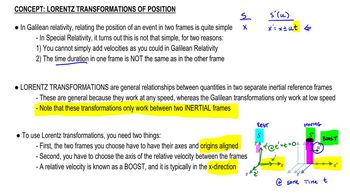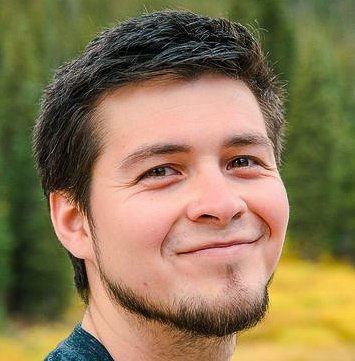35. Special Relativity
Lorentz Transformations
Learn with other creators
Practice this topic
- Multiple Choice
In a lab frame, S, an object crosses a distance of 15 m in 10 s. In an initially aligned frame S', moving at 1000 km/s in the x-direction relative to S, how far a distance does the object have to travel, and in what time does it travel the distance?
622views4rank2comments - Multiple Choice
In a particle accelerator, a neutron is traveling at a speed of 0.7 c, as measured by you in a laboratory. This neutron decays (becoming a proton), ejecting an electron. If you measure the electron's speed to be 0.5 c, traveling in the same direction as the neutron, what was the relative speed between the electron and neutron when the neutron decayed? Was the electron ejected forward or backwards relative to the neutron's motion, as 'seen' by the neutron?
667views2rank5comments - Multiple ChoiceAccording to Earth-based observers, the space time coordinates of a collision between two asteroids are . What are the coordinates according to an astronaut moving in the positive x direction at 0.78c?596views
- Multiple ChoiceWhat is the momentum of a proton moving at ?590views
- Textbook Question
An event has spacetime coordinates (x,t) = (1200 m, 2.0 μs) in reference frame S. What are the event's spacetime coordinates (a) in reference frame S' that moves in the positive x-direction at 0.80c and (b) in reference frame S'' that moves in the negative x-direction at 0.80c?
576views - Textbook Question
A laboratory experiment shoots an electron to the left at 0.90c. What is the electron's speed, as a fraction of c, relative to a proton moving to the right at 0.90c?
34views - Textbook Question
Let's examine whether or not the law of conservation of momentum is true in all reference frames if we use the Newtonian definition of momentum: px = mux. Consider an object A of mass 3m at rest in reference frame S. Object A explodes into two pieces: object B, of mass m, that is shot to the left at a speed of c/2 and object C, of mass 2m, that, to conserve momentum, is shot to the right at a speed of c/4. Suppose this explosion is observed in reference frame S' that is moving to the right at half the speed of light. Use the Lorentz velocity transformation to find the velocities and the Newtonian momenta of B and C in S'.
32views - Textbook Question
The star Delta goes supernova. One year later and 2.0 ly away, as measured by astronomers in the galaxy, star Epsilon explodes. Let the explosion of Delta be at xD = 0 and tD = 0. The explosions are observed by three spaceships cruising through the galaxy in the direction from Delta to Epsilon at velocities v1 = 0.30c, v2 = 0.50c, and v3 = 0.70c. All three spaceships, each at the origin of its reference frame, happen to pass Delta as it explodes. What are the times of the two explosions as measured by scientists on each of the three spaceships?
33views





